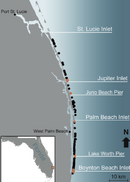- Messages
- 21,444
- Reaction score
- 21,653
- Location
- Philadelphia and Boynton Beach
- # of dives
- 2500 - 4999
From REEF newsletter:
Researchers from the Marine Megafauna Foundation, Jessica Pate and Andrea Marshall, show strong evidence that south Florida features a nursery ground for manta rays, only the third such special place known for the species.
The results, published last month in the journal Endangered Species Research, are surprising, given the proximity to large numbers of people and human activity. Pate spent hundreds of hours conducting visual boat-based surveys between Jupiter Inlet and Boynton Beach between June 2016 to November 2019 to locate and identify individual manta rays from their color patterns and markings. During that time, she identified 59 individuals, and saw several multiple times.
While the warm south Florida waters seem conducive to young manta growth, there is a trade-off; 46 percent of the individuals showed evidence of injury or scarring from boat propellers, fishing equipment, or other unidentified causes. The authors used the REEF Volunteer Fish Survey Project database to establish a baseline of sighting frequency for the species in Florida. They noted a very low frequency of occurence by REEF surveyors (<1% statewide); remarkable given that almost 45,000 REEF surveys have been conducted in Florida waters since 1993. As an avid diver herself, Pate anecdotally knew it was rare, but having the REEF database to provide quantitative information is a good example of the strength and value of REEF's citizen sicence dataset. It also is a good reminder about the importance of non-sightings.
https://www.int-res.com/articles/esr2020/43/n043p051.pdf
Researchers from the Marine Megafauna Foundation, Jessica Pate and Andrea Marshall, show strong evidence that south Florida features a nursery ground for manta rays, only the third such special place known for the species.
The results, published last month in the journal Endangered Species Research, are surprising, given the proximity to large numbers of people and human activity. Pate spent hundreds of hours conducting visual boat-based surveys between Jupiter Inlet and Boynton Beach between June 2016 to November 2019 to locate and identify individual manta rays from their color patterns and markings. During that time, she identified 59 individuals, and saw several multiple times.
While the warm south Florida waters seem conducive to young manta growth, there is a trade-off; 46 percent of the individuals showed evidence of injury or scarring from boat propellers, fishing equipment, or other unidentified causes. The authors used the REEF Volunteer Fish Survey Project database to establish a baseline of sighting frequency for the species in Florida. They noted a very low frequency of occurence by REEF surveyors (<1% statewide); remarkable given that almost 45,000 REEF surveys have been conducted in Florida waters since 1993. As an avid diver herself, Pate anecdotally knew it was rare, but having the REEF database to provide quantitative information is a good example of the strength and value of REEF's citizen sicence dataset. It also is a good reminder about the importance of non-sightings.
https://www.int-res.com/articles/esr2020/43/n043p051.pdf






